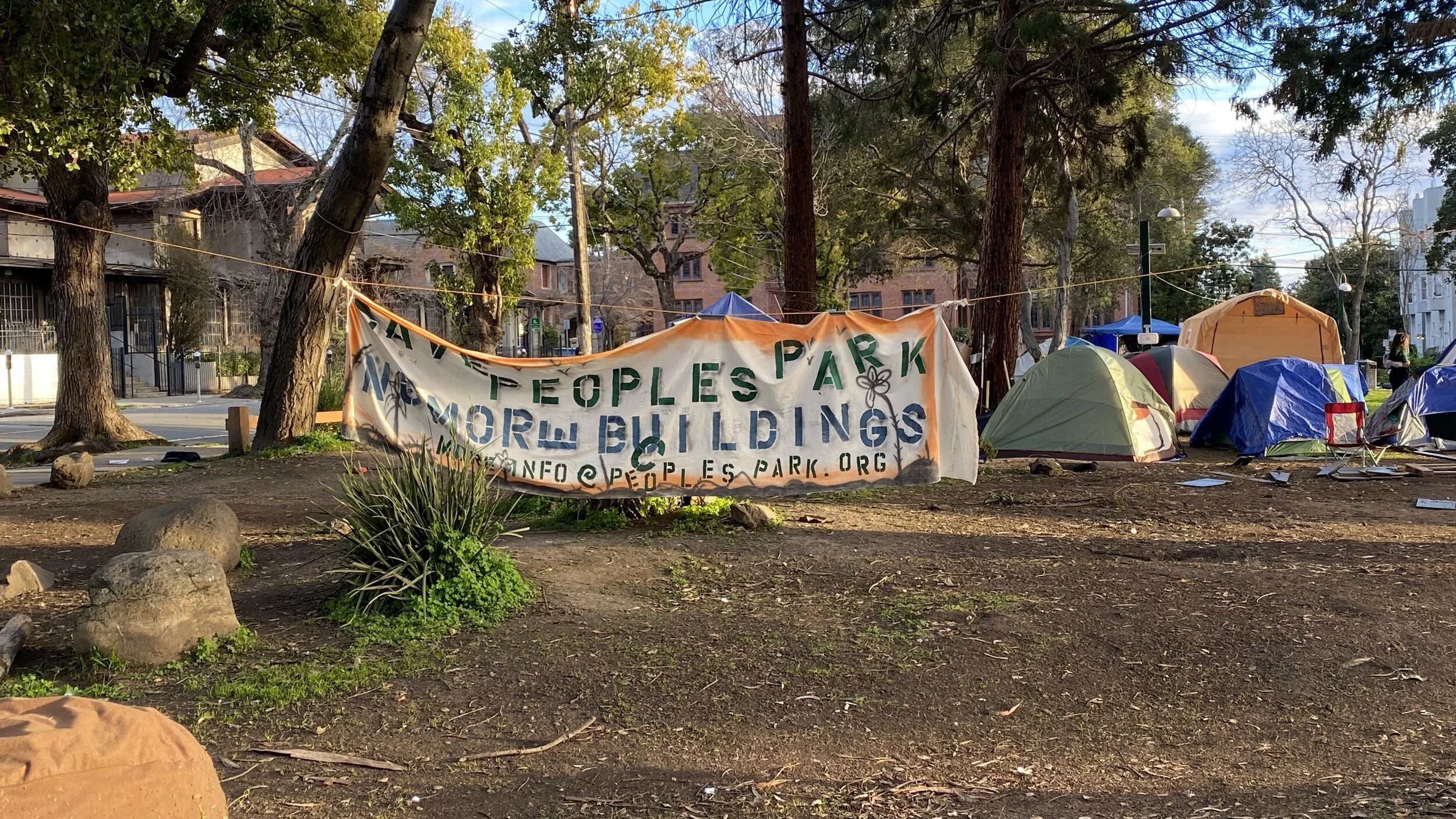Environmental Justice
Featured Posts
When you think of mindfulness, what do you picture? Maybe someone meditating and practicing deep breathing, or someone journaling by candlelight before bed. Or, maybe someone in glittering platform heels pole dancing with a hypnotic flow to Hiatus Kaiyote…
Over the past few years, land acknowledgements have become commonplace at UC Berkeley. You may see them in email signatures, lecture slides, and introductions to webinars. All too often, once the slide is clicked through or the next guest speaker takes the stage, the land acknowledgment, or any further information regarding Indigenous land and sovereignty, is not brought up again…
All posts
For anyone interested in the liberation of land, people, and more-than-human beings, it is incredibly meaningful to see art that critically engages with nature. Take Indigenous Brazilian artist Jaider Esbell’s piece The Conversation of Intergalactic Entities to Decide the Universal Future of Humanity (2021). It speaks to the nagging uncertainty that so many feel amidst the climate crisis and environmental destruction globally.
The Student Environmental Resource Center (SERC) held their annual Earth Week programming from Monday, April 18 to Friday, April 22. This year’s theme was “Wildflowers: Resilience, Resistance, and Growth”. The week was advertised via social media, an email sent by Chancellor Carol Christ, word-of-mouth, and the Environmental Community slack space.
When you think of mindfulness, what do you picture? Maybe someone meditating and practicing deep breathing, or someone journaling by candlelight before bed. Or, maybe someone in glittering platform heels pole dancing with a hypnotic flow to Hiatus Kaiyote…
Over the past few years, land acknowledgements have become commonplace at UC Berkeley. You may see them in email signatures, lecture slides, and introductions to webinars. All too often, once the slide is clicked through or the next guest speaker takes the stage, the land acknowledgment, or any further information regarding Indigenous land and sovereignty, is not brought up again…
Climate change, and the threat of wildfire that accompanies it, is often equated to a great, existential war between the extreme forces of nature and humanity. Much like wartime commendations of the men and women fighting on the frontlines, wildland firefighters are celebrated as the last line of defense on the wilderness frontier…
Nowhere is the impact of the years-long drought and system of dams seen as intensely on the native salmon populations of California. Rising water temperatures in California have wrought enormous damage on salmon populations; some 14,000 of the 16,000 Chinook salmon eggs died around the Sacramento area this year alone.
The intersection between the environmental and feminist movements may seem clear. For example, in climate-related disasters women are 14 times more likely to perish. However, the ecofeminism framework illustrates that this connection runs much deeper…
The UC Green New Deal Coalition (UC GND) — a democratically organized, grassroots organization — works to promote environmental justice and limit actions that contribute to the climate crisis on UC campuses. In hopes of actively advocating for the termination of the Cogeneration Plan, the UC GND organized a set of events for Climate Justice Week, including an Anti-Cogen rally on campus.
On October 28, 2021, the Berkeley Food Institute brought together a panel of Black farmers, organizers, scholars, and activists to bring awareness to the ongoing struggles of Black agrarians and share their stories of anguish, resilience, and hope. Because the majority of Black farmers reside in the southern United States, their battle is one that is rarely discussed among west coast academic institutions…
Los Angeles is one of the largest cities in the United States and is widely known due to its portrayal in the media: a place people should visit if they aspire to be movie stars, Instagram models, or have a high social media following. It is this portrayal that has accelerated the green gentrification that is occurring to attract the young adult population.
In fall of 2019, UC Berkeley undergraduate students formed “Pour Out Pepsi,” (POP) a campaign dedicated to breaking UC Berkeley’s corporate partnership with PepsiCo, Inc. As UC Berkeley votes to renew their contract with PepsiCo, POP is showing the campus that when universities function like businesses, they betray their commitments to their students.
When it comes to consumerism, nearly nothing represents wide scale materialism the way the fashion industry does. The fashion industry emits 10% of the world's carbon emissions, and 85% of all textiles go to landfills each year. In addition, people are buying more clothes and throwing them out at a faster rate…
In the wake of a global pandemic that has disproportionately impacted Black Americans and repeated acts of police brutality against people of color, a renewed sense of awareness around systemic racism in the United States has emerged. As a result, activists have been calling for consumers to purchase from Black-owned businesses in an attempt to combat the racial injustices suffered by the Black community.
It is becoming increasingly evident that climate change is rapidly changing the Earth humans inhabit. Places like Guatemala and Indonesia have long periods of drought, followed by flooding that destroys their homes and environment. In the United States, California is experiencing extended fire seasons, while Florida and Louisiana have hurricane after hurricane.
In the last year, climate activism has become more prominent, especially among young people to make their voices heard seeing that they will be the generation that is highly impacted by global warming and climate change. Youth vs Apocalypse (YVA) is an environmental justice organization started by high school students from Oakland that have fought against inequities perpetuated by environmental issues.
It has been a big year for parks. In the past twelve months of limited indoor activity, many people have rediscovered the joy of gathering in neighborhood and regional green spaces for leisure time, exercise, or a socially distanced hangout.
As the University tries to push through development, the fight for social and environmental justice must rise to meet the moment
Democrats lost big in the US House in the 2020 elections but progressives emerged unscathed. Nearly every progressively-aligned candidate kept their seat this year, bolstering the claim that progressive values are in demand. Young people and Black, Indigenous, people of color (BIPOC) want and need bold policies on climate, healthcare, and racial inequity, and their demands were made clear in these elections.
Social media influencers and dietitians alike have made avocados the quintessential health food. Pinterest boards of the abundant ways to eat avocados--from guacamole to avocado toast-- have increased sales and popularity of the fruit. While seeming like a harmless commodity, this growth in demand has had environmental justice implications for the farmers who grow these fruits.
This year, Prince William, Duke of Cambridge, launched a new project: the Earthshot Prize. The Earthshot prize at its core is simple: if you come up with an innovative solution to five core environmental issues you can win one million pounds. These core issues, or “Earthshots,” are: protect & restore nature, clean our air, revive our oceans, build a waste-free world, and fix our climate.
For many Americans, the Thanksgiving experience is one deeply ingrained in family dinners, children’s books, and elementary school plays, where miniature versions of Pilgrims and Indians depict a respectful encounter and shared meal. The narrative usually ends there, the supporting cast of friendly Indians to exit stage left while the Pilgrims show off newfound agricultural skills and resilience in a new land. To say this narrative leaves out important details is an understatement.
“Let's say for the sake of argument that all of the water levels around the world rise by, let's say, five feet over the next 100 years. Say ten feet over the next 100 years. And it puts all of the low-lying areas on the coast underwater. Let's say all of that happens. You think people aren’t going to sell their houses and move?”
Anyone following the 2020 US election knows that Arizona flipped blue for Democratic nominee Joe Biden. However, they may not have heard about the role Native Americans in the Navajo Nation played in turning the swing state blue for the second time in seventy years, where, despite facing the most severe rates of COVID-19 in the country, reportedly 60-90% of their eligible registered voters went for Biden. The Democratic party and liberals everywhere owe a tremendous debt of gratitude to the Navajo Nation, and this debt should only be repaid by supporting the Land Back movement and the fight for Indigneous land sovereignty everywhere.
As the constitutional convention came to a close in 1789, Benjamin Franklin looked at the armchair that Washington sat in, with a sun painted on its headboard. As he signed the new Constitution, he said, and James Madison later recorded, “ [I] looked at that behind the President without being able to tell whether it was rising or setting: But now at length I have the happiness to know that it is a rising and not a setting Sun.” Franklin understood that unity was made through progress, and this was a monumental breakthrough. Although the framer’s refusal to address the horrors of slavery, genocide of Native Americans, and rampanant sexism would lead to centuries of struggle and strife, it was the most progressive government document ever seen by the western world. Since it’s signing, history has proven Franklin right: this country’s best moments have been when we embraced bold progressivism, and our darkest days have followed our complacency and inaction.
A 2016 United Nations Report on Emerging Issues of Environmental Concern is getting new attention in light of the global Coronavirus pandemic. A large section of the report details the increasing risk of zoonosis, or the process of animal based viruses mutating to infect humans, which is the process by which coronaviruses infect humans.
Let’s listen to leaders of environmental justice movements and hold cities accountable for processing their own waste. For the sake of public, health, land, and oceanic systems, we must move beyond the blue bins to reach a greener future.
Between April 17 and April 27, UC Berkeley hosted its third and final open house on the People’s Park Housing Project. The plan includes 950 to 1,200 student beds and 75 to 125 apartments for people currently experiencing homelessness or very low-income residents, open space, and a food market.
In a quick survey of the many viral videos and stories of environmentally-related COVID-19 stories, they can be broken down into two categories: large scale trends of climate, carbon, and oil, and stories of changing animal behavior. Of these categories we can ask two questions: is this truly a coronavirus related trend, and if so, how long will it last?
After the fires of November 2018, and the power outages of last fall, I set out to build a high value, versatile disaster kit that I could store in my closet and carry on my back. Here’s how I did it, and how you can too.































The Student Environmental Resource Center (SERC) held their annual Earth Week programming from Monday, April 18 to Friday, April 22. This year’s theme was “Wildflowers: Resilience, Resistance, and Growth”. The week was advertised via social media, an email sent by Chancellor Carol Christ, word-of-mouth, and the Environmental Community slack space.